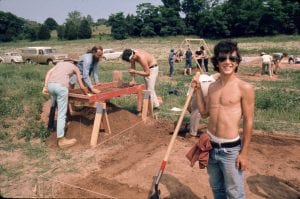I began in archaeology as a 15-year old high school student excavating at the Thunderbird Paleoindian site near Front Royal (VA) – that’s me smiling for the camera on my very first day in the field – and have been at it ever since. My undergraduate education was in Anthropology (with a minor in soils) at the University of Maryland (B.A. 1977). I then crossed the country for graduate school at the University of Washington in Seattle, doing coursework in archaeology and Quaternary sciences (the latter through the Quaternary Research Center). After earning my M.A. (1979) in Anthropology /Archaeology, I was a Predoctoral Fellow in the Department of Anthropology at the Smithsonian Institution (1981-1982), then returned to the University of Washington to complete my Ph.D. (1984).
Newly-minted degree in hand, I joined the SMU Department of Anthropology as an Assistant Professor in the summer of 1984, and never left. I am now the Henderson-Morrison Professor of Prehistory, and the Executive Director of the Quest Archaeological Research Program. In addition, I am an Affiliate Professor in Prehistory, Climate and Environment, at the Centre for GeoGenetics, Globe Institute, University of Copenhagen, Denmark. In Spring 2019, I was a Beaufort Visiting Scholar at St. John’s College, Cambridge University, Cambridge, UK.
My research centers on the origins, antiquity, and adaptations of the first Americans (Paleoindians), who colonized the North American continent at the end of the Pleistocene (Ice Age). I explore all that, and more, in my latest book, a new edition of my First peoples in a new world (2021). More details and links to many of my other works (including podcasts with Steven Rinella and the good folks at MeatEater), can be found here and here.
I am a Fellow of the American Association for the Advancement of Science (elected 1989), a Member of the National Academy of Sciences (2009) and The Academy of Medicine, Engineering and Science of Texas (2009), and a Fellow of the American Academy of Arts and Sciences (2013).
The banner image above shows the LGM (Last Glacial Maximum) terminal moraine of the Taylor River Glacier Complex, Colorado, elevation ~2950 m above sea level (~9700 ft asl). A fly fisherman to the right of center provides a scale. We cored a moraine-dammed lake upvalley to gain a record of the environment at the time Folsom groups occupied the Mountaineer site in the nearby Gunnison Basin (see the new[ish] volume on the site by Andrews et al. 2021).

